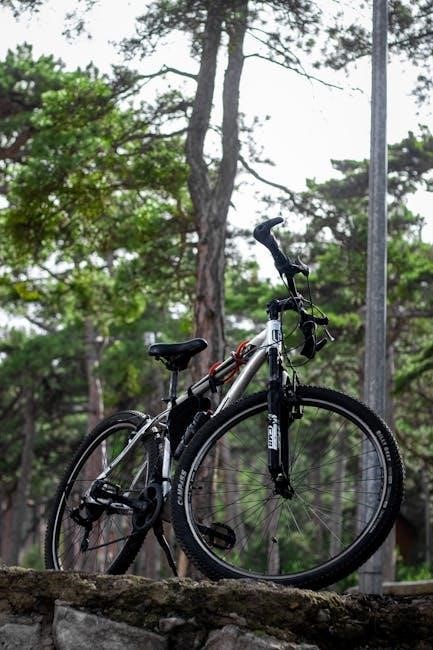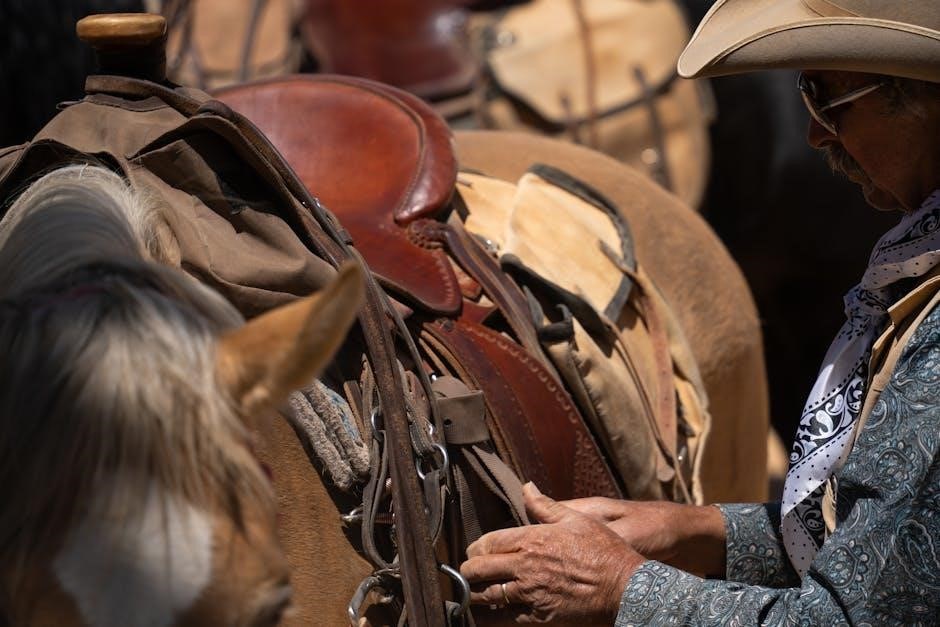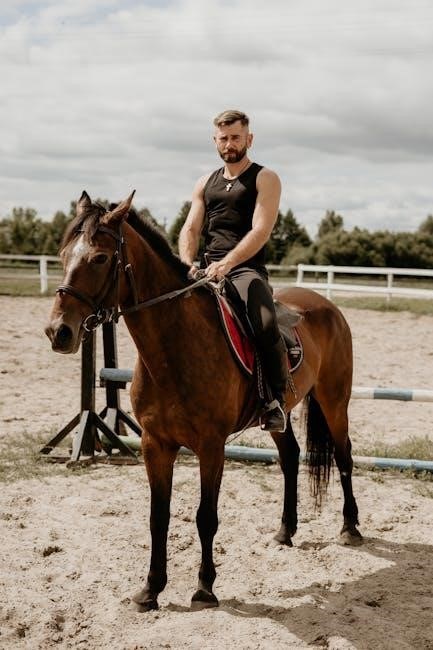Saddle fitting is essential for both horse and rider comfort, ensuring proper alignment and preventing long-term issues. A well-fitted saddle enhances performance and overall riding experience.
Why Proper Saddle Fit is Essential
Proper saddle fit is crucial for both the horse’s welfare and the rider’s performance. A well-fitted saddle ensures even weight distribution, preventing pressure points that can cause discomfort or injury. Poor fit can lead to restricted movement, muscle strain, and long-term damage to the horse’s back. For the rider, a correctly fitted saddle provides stability, balance, and control, enhancing communication with the horse. It also reduces the risk of rider fatigue and discomfort during long rides. Ultimately, proper saddle fit promotes harmony between horse and rider, optimizing comfort, performance, and overall riding experience. Regular assessments are vital as horses’ shapes and needs can change over time.
Overview of the Saddle Fitting Process
The saddle fitting process involves a systematic evaluation to ensure optimal comfort and performance for both horse and rider; It begins with measuring the horse’s back to determine the correct saddle size and style. Assessing wither clearance and gullet space ensures proper fit and prevents pressure points. The saddle is then positioned correctly, balancing evenly to avoid restricting movement. Rider-specific adjustments, such as seat size and flap length, are made to ensure comfort and control. Regular check-ups are essential, as horses’ shapes and needs can change over time. This comprehensive approach ensures a harmonious fit, promoting long-term health and performance for both horse and rider.

Understanding the Basics of Saddle Fitting
Understanding saddle fitting involves knowing key elements like tree points, panels, and gullet space. Proper fit ensures even weight distribution, preventing discomfort and injury, and enhancing performance.
Key Terms and Definitions
Understanding key terms is crucial for proper saddle fitting. The tree provides the saddle’s internal framework, while panels cushion the horse’s back. Gullet space refers to the clearance between the tree points, ensuring no pressure on the spine. Withers are the bony points at the horse’s shoulder, requiring adequate clearance. Saddle balance ensures the seat is level, and flaps adjust to fit the rider’s leg; Correct terminology helps identify proper fit, ensuring comfort and performance for both horse and rider. These definitions form the foundation for evaluating and adjusting saddles effectively.
The Importance of Saddle Fit for Horse and Rider
Proper saddle fit is vital for both the horse and rider, ensuring comfort, performance, and long-term health. A well-fitted saddle prevents pressure points, discomfort, and potential long-term damage to the horse’s back and muscles. For the rider, it provides stability, balance, and optimal control, enhancing communication with the horse. Poor saddle fit can lead to pain, restricted movement, and even behavioral issues in horses, while riders may experience discomfort or difficulty maintaining proper posture. A correctly fitted saddle promotes harmony between horse and rider, improving overall performance and reducing the risk of injury. It is essential for a safe and enjoyable riding experience.

Evaluating the Saddle
Evaluating the saddle involves checking its condition, balance, and fit. Ensure proper tree points, even panel contact, and adequate gullet width for the horse’s spine clearance and comfort.
How to Visually Inspect a Saddle
Visually inspecting a saddle begins with checking its symmetry and balance. Look for even panel contact and proper gullet width to ensure clearance for the horse’s spine. Inspect the tree points for correct alignment and ensure the saddle is free from excessive wear or damage. Check the flocking or padding for uniformity and signs of compression. Examine the billets and girth straps for stability and condition. Ensure the saddle is level when placed on the horse’s back, with adequate wither clearance. A thorough visual inspection helps identify potential issues before they affect the horse’s comfort or performance.
Hands-On Evaluation of Saddle Fit
A hands-on evaluation involves placing the saddle on the horse to assess its fit dynamically. Slide the saddle onto the horse’s back, ensuring it rests naturally without forcing it into position. Check for even contact along the panels and proper balance. Run your hand under the saddle to feel for pressure points or gaps, ensuring consistent contact. Test the saddle’s movement by gently rocking it side to side and front to back. A well-fitted saddle should allow freedom of movement for the horse’s shoulders and remain stable during these tests. This step helps confirm the visual inspection and ensures optimal fit for both horse and rider.

Fitting the Saddle to the Horse
Proper saddle fitting ensures the saddle is level, with adequate wither clearance and gullet space, preventing discomfort and injury to the horse.
Measuring the Horse’s Back for Saddle Fit
Measuring the horse’s back is crucial for proper saddle fit. Start by identifying the wither height and back length, ensuring the saddle aligns correctly. Use a flexible measuring template or a soft tape measure to trace the horse’s topline, noting the curvature and any asymmetry. This helps determine the appropriate tree size and saddle length. Ensure the template reflects the horse’s natural shape, as changes in muscle tone or weight can alter measurements. Regularly updating these measurements ensures the saddle remains comfortable and supportive, preventing pressure points or restricted movement. Accurate measurements form the foundation of a well-fitted saddle.
Assessing Wither Clearance and Gullet Space
Proper clearance at the withers and adequate gullet space are critical for saddle fit. The withers should have about 2-3 fingers of space above the saddle to prevent pressure. The gullet must be wide enough to avoid contact with the horse’s spine, ensuring spinal comfort and movement; To assess, place the saddle on the horse’s back and check for even weight distribution. Use a wither gauge or a soft measuring tool to ensure the saddle does not impinge on the withers or spine. Inadequate clearance can lead to pain, restricted movement, or long-term damage. Always ensure the saddle aligns with the horse’s natural shape and allows for proper spinal clearance and wither ease.
How to Position the Saddle Correctly
Correct saddle positioning is vital for both horse and rider comfort. The saddle should be placed 2-3 fingers behind the withers, ensuring adequate clearance and proper weight distribution. The gullet space must align with the horse’s spine, allowing for freedom of movement. To achieve this, gently slide the saddle forward and backward to find the natural resting position. Ensure the saddle is centered and level, with the pommel slightly higher than the cantle. Use a soft measuring tool or wither gauge to verify proper alignment. A correctly positioned saddle promotes even weight distribution, prevents pressure points, and ensures the horse’s comfort and mobility. Regular checks and adjustments are essential to maintain optimal fit and performance.

Fitting the Saddle to the Rider
Fitting the saddle to the rider involves balancing comfort, support, and mobility. Assess seat size, stirrup length, and flap alignment to ensure proper fit for various riding styles.
How to Determine Rider Size and Saddle Fit
Determining rider size and saddle fit involves assessing seat size, stirrup length, and flap alignment. The saddle seat should accommodate the rider’s sit bones comfortably, with a 1-2 finger gap behind the thigh. Stirrup length is adjusted to allow a 90-degree angle behind the knee when riding. Flaps should align with the rider’s leg length, providing support without restriction. Weight and riding style also influence fit, as heavier riders may require wider seats, while shorter riders need shorter flaps. Proper fit ensures balance, control, and comfort, optimizing riding performance and minimizing discomfort or strain.
Adjusting the Saddle for Rider Comfort
Adjusting the saddle for rider comfort involves several key considerations. First, ensuring the correct seat size is crucial, as a seat that is too small can cause discomfort, while one that is too large may hinder control. The saddle’s position on the horse’s back is also vital, as improper placement can lead to discomfort for both the horse and rider. Stirrup length should be adjusted to maintain a balanced riding position, with feet properly aligned, typically aiming for a 90-degree angle behind the knee. The flap length should be tailored to the rider’s leg length, preventing pressure points and ensuring freedom of movement. Additionally, the saddle’s padding and material play significant roles in comfort, with options for added accessories like seat pads for extra cushioning. Riders should also consider their weight and riding style, as these factors influence the necessary support and flexibility of the saddle. Adjustable features such as stirrup bars and gullet plates can be fine-tuned for individual comfort, and maintaining the saddle’s condition through regular cleaning and conditioning is essential. Finally, seeking professional fitting ensures the saddle is optimized for both horse and rider, providing the best possible comfort and performance.
Ensuring Proper Saddle Fit for Different Riding Styles

Proper saddle fit is crucial for various riding styles, as each discipline requires specific adjustments. For dressage, a deeper seat and longer stirrups provide balance, while show jumping saddles often feature forward-cut flaps for greater freedom. Endurance riding demands lightweight, flexible saddles with ample padding to reduce fatigue. Saddle fit must also accommodate the horse’s unique back shape and movement, ensuring even weight distribution and preventing pressure points. Riders should consult professionals to tailor their saddles to their riding style, ensuring optimal comfort and performance. Regular adjustments are essential as both horse and rider evolve over time. Proper fit enhances harmony and effectiveness in any discipline.

Common Mistakes to Avoid
Avoiding common saddle fitting mistakes is key to ensuring comfort and performance. These include incorrect sizing, poor saddle positioning, and neglecting regular adjustments for optimal fit and functionality.
Mistakes in Saddle Fitting for the Horse
Common mistakes in saddle fitting for the horse include inadequate wither clearance, improper gullet space, and poor saddle positioning. These errors can lead to pressure points, restricted movement, and discomfort for the horse. Ignoring the horse’s back shape and muscle development can result in a saddle that pinches or shifts excessively. Additionally, failing to consider the horse’s age, breed, and athletic demands often leads to ill-fitting saddles. Regular adjustments are essential, as horses’ bodies change over time due to growth, training, or health conditions. Proper fit is crucial to prevent long-term issues like back strain or behavioral problems, ensuring the horse’s comfort and well-being.
Common Errors in Rider Saddle Fit
Common errors in rider saddle fit include incorrect saddle size, poor flap length, and improper cinching. A saddle that is too small or too large can cause discomfort and restrict movement; Flaps that are too short or too long may not support the rider’s leg correctly, affecting control and balance. Additionally, cinching the saddle too tightly or too loosely can lead to instability or pressure points. Riders often overlook the importance of saddle fit for their specific riding style, such as jumping or dressage, which requires tailored support. Regular adjustments and professional fittings are essential to ensure optimal comfort and performance for both horse and rider.

Maintenance and Care
Regular cleaning, conditioning, and proper storage maintain saddle quality. Check for wear and tear, and ensure correct storage to prevent damage and extend lifespan.

How to Clean and Maintain Your Saddle
Regular cleaning and maintenance are crucial to extend the life of your saddle. Start by removing dirt and dust with a soft brush or cloth. Use a mild soap solution to wipe down the leather, avoiding harsh chemicals that can damage the material. For stubborn stains, apply a small amount of leather conditioner. Allow the saddle to dry naturally, away from direct sunlight. Condition the leather periodically to maintain its suppleness and prevent cracking. Inspect the saddle regularly for signs of wear, such as loose stitching or broken parts, and address them promptly. Proper care ensures your saddle remains comfortable and functional for both horse and rider.
Storing the Saddle Properly
Proper saddle storage is essential to maintain its condition and longevity. Store your saddle in a cool, dry place away from direct sunlight to prevent fading or cracking. Use a breathable saddle cover to protect it from dust and moisture. Avoid leaving the saddle on a rack for extended periods, as this can cause pressure points. Instead, place it on a padded surface or hang it with a wide strap to distribute weight evenly. Regularly inspect the saddle for signs of wear or damage before storing. Ensure the saddle is clean and dry to prevent mold or mildew. Proper storage ensures your saddle remains in excellent condition for years of reliable use.
Regular Check-Ups for Saddle Fit
Regular check-ups are vital to ensure your saddle continues to fit both you and your horse perfectly. Horses’ bodies change over time due to age, conditioning, or health, which can affect saddle fit. Schedule professional evaluations at least twice a year or after significant changes in your horse’s shape or your riding habits. Look for signs of poor fit, such as discomfort, uneven wear, or performance issues. A trained saddle fitter can assess the saddle’s alignment, tree points, and gullet space to ensure optimal comfort and performance. Regular check-ups help prevent long-term damage and maintain the well-being of both horse and rider.

Troubleshooting Saddle Fit Issues
Identify common saddle fit issues like uneven wear, discomfort, or performance problems. Adjustments may include repositioning, padding, or reflocking to restore proper alignment and comfort.
Identifying Signs of Poor Saddle Fit
Poor saddle fit can lead to visible discomfort in horses, such as restricted movement, uneven sweat patterns under the saddle, or visible gullet clearance issues. Physical signs include sores, rubs, or hair loss along the back and withers. Riders may feel imbalanced, with difficulty maintaining proper posture or experiencing pain in the lower back or legs. Additionally, the saddle may shift excessively or sit unevenly, indicating improper fit. Regular inspections and assessments are crucial to detect these issues early, ensuring both horse and rider remain comfortable and perform optimally. Addressing these signs promptly can prevent long-term damage and improve overall riding quality.
Adjustments and Corrections for Better Fit
Adjusting a saddle for better fit involves evaluating current positioning and making targeted corrections. Start by ensuring proper wither clearance and gullet space, as these are critical for horse comfort. Adding or removing padding can help achieve balance, while adjusting the gullet plates or tree points may be necessary for optimal fit. Riders should also check stirrup length and seat size to ensure alignment and comfort. Regularly re-evaluating the saddle’s fit as the horse’s shape changes is essential. Small tweaks, such as shifting the saddle forward or backward, can make a significant difference. Professional guidance is recommended for complex adjustments to avoid causing discomfort or imbalance for both horse and rider.
A well-fitted saddle ensures comfort, prevents injuries, and enhances performance for both horse and rider. Regular adjustments and professional guidance are key to long-term success and happiness.
Final Tips for Achieving the Perfect Saddle Fit
Achieving the perfect saddle fit requires attention to detail and regular adjustments. Always ensure proper wither clearance and gullet space to prevent discomfort or injury. Position the saddle correctly, avoiding interference with the horse’s shoulders and spine. Use a saddle fitting template to track changes in your horse’s shape over time. Regularly check the saddle’s condition and adjust as needed. Seek professional guidance if unsure, as poor fit can lead to long-term issues. Remember, a well-fitted saddle enhances performance, comfort, and the overall riding experience for both horse and rider.
The Long-Term Benefits of Proper Saddle Fitting
Proper saddle fitting offers long-term benefits for both horse and rider, ensuring comfort, performance, and health. A well-fitted saddle prevents injuries and discomfort, promoting a stronger bond between horse and rider. It also enhances the horse’s mobility and freedom of movement, reducing the risk of long-term physical issues. Regular adjustments maintain optimal fit as the horse’s shape changes, ensuring continued comfort and performance. Proper fitting also extends the saddle’s lifespan and supports the rider’s posture and balance. Over time, it fosters a more enjoyable and effective riding experience, benefiting both the horse’s well-being and the rider’s progress in their equestrian journey.

